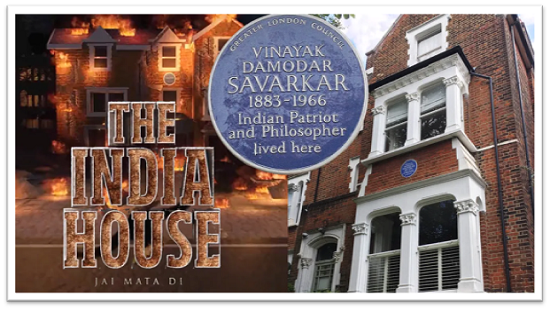
Maharashtra’s Big Cultural Move: State to Take Over London’s Historic India House and Build Grand Sambhaji Maharaj Memorial
When a government chooses to preserve a landmark tied to its national story, it is making a statement about memory, identity, and long-term cultural direction. Maharashtra’s decision to acquire London’s historic India House and convert it into a memorial marks such a moment of cultural consolidation. Anchored in history yet forward-looking in intention, the initiative aligns with the State’s growing focus on heritage conservation and cultural infrastructure.
Announced by Cultural Affairs Minister Ashish Shelar after his official visit to London, this plan reflects a methodical and structured effort rather than an impulsive declaration. India House, once the residence of freedom fighter Vinayak Damodar Savarkar, is not just a physical structure in a foreign city, it is a site intertwined with India’s freedom struggle and early nationalist movements. Preserving it as a memorial is both a tribute and an educational gesture aimed at future generations.
A Historic Landmark with a Revolutionary Past
Originally established in the early 20th century as a student residence, India House gradually transformed into a centre for revolutionary activity. Under Savarkar’s influence, it became a hub for nationalist discussions and anti-colonial initiatives, drawing young reformers and intellectuals. Its significance stems not only from Savarkar’s presence but also from its association with various individuals involved in shaping the freedom movement.
This historical background makes India House an important cultural asset. By bringing it under State care, Maharashtra aims to preserve a location that once served as a breeding ground for political thought and action. The preservation plan highlights its deep link to India’s struggle for independence and positions it as a formal memorial for public understanding.
A Structured Plan Backed by Interdepartmental Coordination
The government’s decision is supported by a detailed administrative process. Following Shelar’s London visit, which also included retrieving the historic sword of Raghuji Raje Bhosale, a review meeting was convened at the Cultural Affairs Ministry. It included MLA Devyani Farande, along with officials from General Administration, Cultural Affairs, and Archaeology departments.
The proposal received clearance for formal planning and will now move forward under a committee chaired by Mitra. This committee will include representatives from the General Administration, Cultural Affairs, Archaeology, and Finance departments. Its primary task will be to examine the legal, financial, and administrative aspects of acquiring India House, preparing a comprehensive report for Chief Minister Devendra Fadnavis.
This structured approach suggests that the acquisition is not symbolic alone, it is a planned administrative undertaking designed to respect international procedures and ensure historic preservation.
From Ownership to Conservation: Next Steps
After the acquisition, the State government plans to begin conservation efforts aimed at preserving the building and curating it into a memorial dedicated to India’s freedom struggle. The memorial will highlight the contribution of India House and the individuals associated with it during the anti-colonial movement.
This long-term vision includes examining property laws, maintenance requirements, financial implications, and international coordination. The committee’s findings will guide the next phase of implementation, ensuring that preservation aligns with heritage norms and public accessibility.
Reclaiming Cultural Assets: The Return of Raghuji Raje Bhosale’s Sword
Earlier this year, the State successfully repatriated the “Raghuji Sword” of 18th-century Maratha general Raghuji Bhonsle. Purchased for ₹47.15 lakh at a London auction, the sword was brought back to Mumbai in August. This action reflects a growing focus on retrieving artifacts of historical importance and restoring them to Indian soil.
The retrieval of the sword, coupled with the India House acquisition plan, indicates a broader cultural narrative, one that values historical assets and integrates them into public memory.
Sambhaji Maharaj Memorial: A New Landmark for Ratnagiri
Parallel to the India House initiative, Maharashtra has cleared the construction of a grand memorial for Chhatrapati Sambhaji Maharaj at Sangameshwar in Ratnagiri district. The project, originally announced by Chief Minister Devendra Fadnavis, is being developed with significant scale and ambition.
The memorial is planned on a 5-acre site, with an additional 2 acres acquired for parking and ancillary facilities. During the recent meeting, Minister Shelar received the conceptual drawings for the first phase. Former MLA Pramod Jathar emphasized that the project should be executed in phases and modelled on the grandeur of iconic national monuments.
Shelar directed officials to initiate work on the main memorial structure based on the concept plan. He also called for a detailed report on tourism infrastructure and services surrounding the site, aiming to develop the region as a cultural tourism hub.
A Coordinated Cultural Vision
Present at the meeting were officials from the Cultural Affairs and Archaeology departments, Ratnagiri district administration, the Tehsildar, and the Public Works Department. Their involvement underscores that this is not just a memorial project, it is a coordinated plan to develop an ecosystem around cultural tourism in Ratnagiri.
By pairing the India House project in London with the Sambhaji Maharaj memorial at home, Maharashtra is signalling a dual commitment: to honour its freedom-linked history on foreign soil while strengthening cultural identity within the State.
Conclusion: Preserving Memory, Enhancing Identity
Maharashtra’s decision to acquire India House and its push to build a major Sambhaji Maharaj memorial reflect a deliberate cultural strategy. The initiatives carry historical, educational, and social importance. They aim to protect heritage structures, reclaim symbolic artifacts, and promote cultural tourism. They also seek to connect contemporary citizens with the narratives that shaped the State’s and the nation’s identity.
Through systematic planning, multi-departmental coordination, and a focus on meaningful preservation, the State is investing in its cultural roots while preparing these landmarks for public engagement. These efforts highlight a commitment to ensuring that key sites of historical significance continue to inspire future generations.




